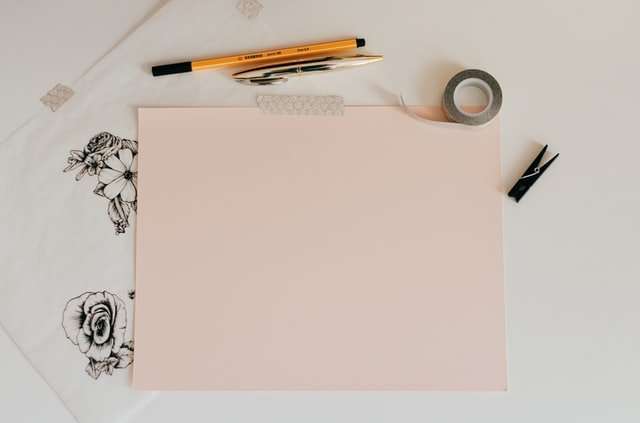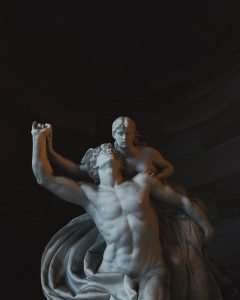Art or design teachers sometimes use words you don’t know in class or on tests, or when you’re doing an art project. It can make you feel dumb.
Maybe the teacher defines the word, or maybe he doesn’t and you just have to figure it out yourself. Sometimes it’s a word that means the same thing as another word you already know, but you don’t realize they both mean the same thing, so it takes a while to understand what the teacher really means. And sometimes there are words that are part of a special art or design vocabulary that is different from the vocabulary of everyday English.
Trying to learn all these words at once can be frustrating because there are too many new things to think about. But if there aren’t too many new things to think about at once, it’s easier to remember them. So I wrote this list of seven art or design vocabulary elements to help you learn the language, one step at a time. And they’re arranged in order from easiest to hardest, so if you try them all one after another, it will be easier than trying to learn them all at once.
Art or Design Vocabulary Elements is a good tool to help you learn the language. It may be an art blog, however that doesn’t mean it is not useful for designers. It is very important to be familiar with the words used in design and art because these are quite different from other people’s vocabulary. For example, if you are an artist, you may use some words to describe your work that sound strange to other people but they understand what you mean.
Art or Design Vocabulary Elements is a resource to help you understand this language through new terms that are more common nowadays such as:
– Minimalism
– Abstract representation
– Op-art
– Pop Art
– Photorealism
This blog offers its visitors a chance to learn about art and how it has evolved, from the beginning of the 20th century up until today. It also provides insight on what influenced artists and why they were inspired by them. In addition, the site provides descriptions about trends, movements, styles and some technical info about art pieces and how they were made. All of these will allow the readers to have a better understanding of art history and all its aspects. You can find out more here: https://artdesignblog.wordpress.com/2016/05/
Mostly I want to help you begin learning about art or design. But in order to do that, I have to talk about art or design. And when I use terms you might not know, I try to explain them.
I’ve put together a list of 7 vocabulary words I run across pretty much every time I look at art or design websites, in hopes that you’ll start to notice them and their meaning.
1) authentic: genuine; real; as it claims to be; faithful to an original; trustworthy – a photojournalist strives for authenticity in his work.
2) beauty: the quality in a person or thing that gives intense pleasure or deep satisfaction to the senses or the spirit – some painters strive for beauty in their work.
3) classic: traditional; of lasting worth or with a timeless quality; not trendy or fashionable. When something is considered a classic, it has stood the test of time and remains popular today; recognized as an important work of art, literature, music, architecture, cinema etc. – many people prefer movies they consider classics over those they don’t consider classic.
4) cross-disciplinary: relating to or involving two or more academic disciplines – in most areas of study there are certain skills and techniques that
Art or design terms are everywhere: on museum walls, in art class, in textbooks, and in the media. Most students learn some of them, but few students learn to use these words accurately and creatively. If a student can’t talk about art or design–and it is a rare student who can–it is like being mute in a foreign country.
How do you study this vocabulary? One way is to keep a journal or notebook where you can record your thoughts, impressions, and reactions as you look around for meaning. Write down the names of things you see or hear about and then research them on the web or at the library. You may find that one word has more than one meaning; keep track of each meaning and its origin. For help with pronunciation, refer to sites such as phoeneticguide.com.
Now write an essay using words from your list. Your essay should be about something that interests you; perhaps it could describe a work of art, architecture, fashion, or design that you know well. Or discuss an idea that intrigues you: How can we best preserve our natural resources? What would life be like if everyone dressed alike? Why do people get married? The more personal your essay is, the better it will be.
In order to make art or design, you must have a command of the language. And as with any language, there are a few key words that you need to know if you want to sound like you know what you’re talking about. I present them here for your pleasure and edification.
One of the things that can hold back a beginning artist is a lack of knowledge of vocabulary. It is especially common among those who have no formal art training. I frequently hear “I don’t know what that means,” and it is frustrating to both parties.
Here are some common terms you’ll find in any art class or design program, with examples of each.
Form: Form is the shape or structure of an object. In an illustration, it is the overall shape of the subject being illustrated. In a painting, it is the paint itself on the canvas. In architecture, it is the overall structure of a building or room.
**Line**: Line is one of the elements of art and design, along with color and texture. You can think of line as your drawing tool—your pencil, pen, or marker. When you draw a straight line, you’re using one line. A wavy line would be two lines on top of each other; a curved line would be one long arc (the most basic type of line).
**Shape**: Shape is what you are drawing when you are drawing lines together to make an object. You can also think about shape as your drawing surface—paper or canvas—when you are working on an artwork
“How does one begin to study art? What is the first step?” It is a question that every new art student asks.
The answer to this question is as diverse as the many types of art in the world. However, there are some guidelines that will help you navigate your way through the world of art and design. Before you begin to study, it would be wise to familiarize yourself with some of the vocabularies and elements associated with art.
Tone:matter-of-fact


